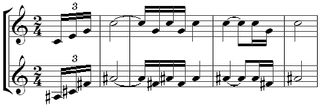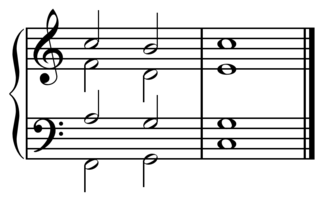In music, the tonic is the first scale degree of the diatonic scale and the tonal center or final resolution tone that is commonly used in the final cadence in tonal classical music, popular music, and traditional music. In the movable do solfège system, the tonic note is sung as do. More generally, the tonic is the note upon which all other notes of a piece are hierarchically referenced. Scales are named after their tonics: for instance, the tonic of the C major scale is the note C.

Atonality in its broadest sense is music that lacks a tonal center, or key. Atonality, in this sense, usually describes compositions written from about the early 20th-century to the present day, where a hierarchy of harmonies focusing on a single, central triad is not used, and the notes of the chromatic scale function independently of one another. More narrowly, the term atonality describes music that does not conform to the system of tonal hierarchies that characterized European classical music between the seventeenth and nineteenth centuries. "The repertory of atonal music is characterized by the occurrence of pitches in novel combinations, as well as by the occurrence of familiar pitch combinations in unfamiliar environments".

Polytonality is the musical use of more than one key simultaneously. Bitonality is the use of only two different keys at the same time. Polyvalence or polyvalency is the use of more than one harmonic function, from the same key, at the same time.
In music theory, the tritone is defined as a musical interval composed of three adjacent whole tones. For instance, the interval from F up to the B above it is a tritone as it can be decomposed into the three adjacent whole tones F–G, G–A, and A–B.
In music theory, a leading-tone is a note or pitch which resolves or "leads" to a note one semitone higher or lower, being a lower and upper leading-tone, respectively. Typically, the leading tone refers to the seventh scale degree of a major scale, a major seventh above the tonic. In the movable do solfège system, the leading-tone is sung as ti.
In music, a whole-tone scale is a scale in which each note is separated from its neighbors by the interval of a whole tone. In twelve-tone equal temperament, there are only two complementary whole-tone scales, both six-note or hexatonic scales. A single whole-tone scale can also be thought of as a "six-tone equal temperament".
An octatonic scale is any eight-note musical scale. However, the term most often refers to the ancohemitonic symmetric scale composed of alternating whole and half steps, as shown at right. In classical theory, this symmetrical scale is commonly called the octatonic scale, although there are a total of 43 enharmonically non-equivalent, transpositionally non-equivalent eight-note sets.
A jazz scale is any musical scale used in jazz. Many "jazz scales" are common scales drawn from Western European classical music, including the diatonic, whole-tone, octatonic, and the modes of the ascending melodic minor. All of these scales were commonly used by late nineteenth and early twentieth-century composers such as Rimsky-Korsakov, Debussy, Ravel and Stravinsky, often in ways that directly anticipate jazz practice. Some jazz scales, such as the bebop scales, add additional chromatic passing tones to the familiar diatonic scales.

Tonality is the arrangement of pitches and/or chords of a musical work in a hierarchy of perceived relations, stabilities, attractions and directionality. In this hierarchy, the single pitch or triadic chord with the greatest stability is called the tonic. The root of the tonic chord forms the name given to the key, so in the key of C major, the note C can be both the tonic of the scale and the root of the tonic chord. The tonic can be a different note in the same scale, when the work is said to be in one of the modes of the scale.
A tone cluster is a musical chord comprising at least three adjacent tones in a scale. Prototypical tone clusters are based on the chromatic scale and are separated by semitones. For instance, three adjacent piano keys struck simultaneously produce a tone cluster. Variants of the tone cluster include chords comprising adjacent tones separated diatonically, pentatonically, or microtonally. On the piano, such clusters often involve the simultaneous striking of neighboring white or black keys.

A semitone, also called a half step or a half tone, is the smallest musical interval commonly used in Western tonal music, and it is considered the most dissonant when sounded harmonically. It is defined as the interval between two adjacent notes in a 12-tone scale. For example, C is adjacent to C♯; the interval between them is a semitone.

An added tone chord, or added note chord, is a non-tertian chord composed of a triad and an extra "added" note. Any tone that is not a seventh factor is commonly categorized as an added tone. It can be outside the tertian sequence of ascending thirds from the root, such as the added sixth or fourth, or it can be in a chord that doesn't consist of a continuous stack of thirds, such as the added thirteenth. The concept of added tones is convenient in that all notes may be related to familiar chords.
The term sixth chord refers to two different kinds of chord, the first in classical music and the second in modern popular music.
Chromaticism is a compositional technique interspersing the primary diatonic pitches and chords with other pitches of the chromatic scale. In simple terms, within each octave, diatonic music uses only seven different notes, rather than the twelve available on a standard piano keyboard. Music is chromatic when it uses more than just these seven notes.
The modern Lydian mode is a seven-tone musical scale formed from a rising pattern of pitches comprising three whole tones, a semitone, two more whole tones, and a final semitone.

In music theory, the harmonic major scale is a musical scale found in some music from the common practice era and now used occasionally, most often in jazz. In George Russell's Lydian Chromatic Concept it is the fifth mode (V) of the Lydian Diminished scale. It corresponds to the Raga Sarasangi in Indian Carnatic music.
In music, polymodal chromaticism is the use of any and all musical modes sharing the same tonic simultaneously or in succession and thus creating a texture involving all twelve notes of the chromatic scale. Alternately it is the free alteration of the other notes in a mode once its tonic has been established.

Diatonic and chromatic are terms in music theory that are most often used to characterize scales, and are also applied to musical instruments, intervals, chords, notes, musical styles, and kinds of harmony. They are very often used as a pair, especially when applied to contrasting features of the common practice music of the period 1600–1900.

Inscape is a 1967 musical composition for orchestra by Aaron Copland, approximately twelve to thirteen minutes in length, and commissioned by and dedicated to the New York Philharmonic for its 125th anniversary. Composed using the twelve-tone technique, the piece has been considered less accessible than much of Copland's earlier music. It is named for Gerard Manley Hopkins's term "inscape", invented:
to suggest 'a quasi-mystical illumination, a sudden perception of that deeper pattern, order, and unity which gives meaning to external forms.' This description, it seems to me, applies more truly to the creation of music than to any of the other arts.
In music, a common tone is a pitch class that is a member of, or common to two or more chords or sets. Typically, it refers to a note shared between two chords in a chord progression. According to H.E. Woodruff:
Any tone contained in two successive chords is a common tone. Chords written upon two consecutive degrees of the [diatonic] scale can have no tones in common. All other chords [in the diatonic scale] have common tones. Common tones are also called connecting tones, and in part-writing, are to be retained in the same voice. Chords which are four or five degrees apart have one common tone. Chords which are three or six degrees apart have two common tones. Chords which are one or seven degrees apart have no tone in common.








